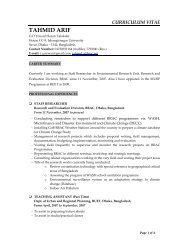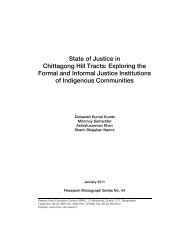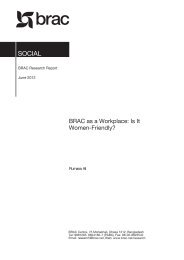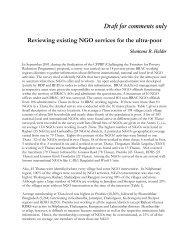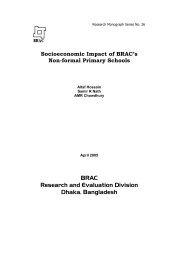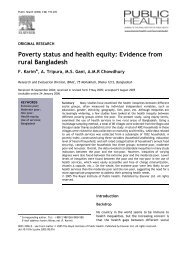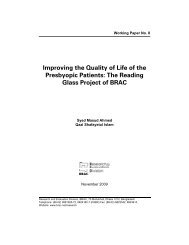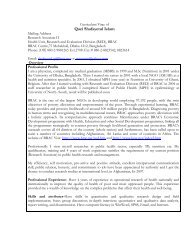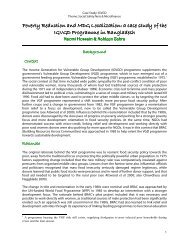Combining health and social protection measures to reach the ultra ...
Combining health and social protection measures to reach the ultra ...
Combining health and social protection measures to reach the ultra ...
You also want an ePaper? Increase the reach of your titles
YUMPU automatically turns print PDFs into web optimized ePapers that Google loves.
Innovation<br />
The changes in international IP legislative frameworks<br />
through treaties are rapidly changing national legislation. And<br />
<strong>the</strong>se changes are profoundly affecting how <strong>health</strong><br />
innovations <strong>reach</strong> <strong>the</strong> poor <strong>and</strong> how public <strong>and</strong> private<br />
research <strong>and</strong> development institutions pursue <strong>the</strong>ir work. IP<br />
rights are sometimes viewed as barriers <strong>to</strong> innovations in<br />
<strong>health</strong> <strong>and</strong> o<strong>the</strong>r areas. In some circumstances, <strong>the</strong>y are. But<br />
this paper argues that overall it is not intellectual property, per<br />
se, that obstructs access, but ra<strong>the</strong>r how intellectual property<br />
is used <strong>and</strong> managed. What matters most is how creatively<br />
public sec<strong>to</strong>r institutions integrate IP considerations in<strong>to</strong> <strong>the</strong>ir<br />
overall business models <strong>and</strong> approaches. Seen in this light,<br />
<strong>the</strong> legislative framework provides a solid foundation for a<br />
stable, predictable judiciary, which also allows <strong>the</strong> public<br />
sec<strong>to</strong>r <strong>to</strong> use a national IP system as a <strong>to</strong>ol <strong>to</strong> achieve its<br />
goals. A stable IP system empowers <strong>the</strong> public sec<strong>to</strong>r <strong>to</strong><br />
imagine, anticipate, <strong>and</strong> act.<br />
The policy choices<br />
Determining how institutions can adopt <strong>and</strong> adapt <strong>the</strong><br />
advantages conferred by TRIPS <strong>and</strong> o<strong>the</strong>r legislative<br />
initiatives is crucial. For example, government policies are<br />
hugely important for establishing <strong>to</strong> what extent public sec<strong>to</strong>r<br />
institutions will practise IP management. In <strong>the</strong> United<br />
States, no o<strong>the</strong>r policy choice had a more significant impact<br />
than <strong>the</strong> Bayh-Dole Act <strong>and</strong> o<strong>the</strong>r legislative <strong>and</strong> policy<br />
decisions in <strong>the</strong> early 1980s. They created conditions that<br />
spurred investment in biotechnology R&D, leading <strong>to</strong><br />
numerous <strong>health</strong> innovations. But above all, <strong>the</strong>se policy<br />
choices greatly affected how universities <strong>and</strong> public sec<strong>to</strong>r<br />
research institutions manage intellectual property <strong>and</strong> <strong>the</strong>ir<br />
relationship with <strong>the</strong> private sec<strong>to</strong>r.<br />
Although <strong>the</strong> circumstances of countries vary enormously,<br />
<strong>the</strong> following set of questions are nearly universally relevant:<br />
when should public sec<strong>to</strong>r R&D centres or universities seek<br />
patent <strong>protection</strong> for <strong>the</strong>ir inventions? What information<br />
related <strong>to</strong> research should <strong>the</strong>y keep confidential, if any?<br />
Under what circumstances should <strong>the</strong> public sec<strong>to</strong>r grant<br />
access (in o<strong>the</strong>r words license) <strong>the</strong>ir intellectual property? And<br />
under what terms? And <strong>to</strong> whom? These questions do not<br />
have simple answers. This is largely because <strong>the</strong> answers will<br />
depend on <strong>the</strong> context in which <strong>the</strong>y emerge. Even within <strong>the</strong><br />
same institution, <strong>the</strong> answers may be diametrically opposed<br />
for different types of inventions. Given <strong>the</strong>se complexities,<br />
what should be <strong>the</strong> government’s role in <strong>the</strong> area of policy?<br />
First of all, establishing an open, transparent government<br />
policy for <strong>the</strong> ownership of publicly funded research is an<br />
important foundation for building sound institutional IP<br />
management. Institutional leaders have little latitude when<br />
<strong>the</strong> underlying rules are opaque or not spelled out.<br />
Second, <strong>the</strong> policy rationale for technology transfer in<br />
public sec<strong>to</strong>r institutions should not be based on anticipated<br />
revenue flows; instead, long-term national, <strong>social</strong>, <strong>and</strong><br />
economic objectives should structure policy decisions – with<br />
public benefit as <strong>the</strong> key fac<strong>to</strong>r. Indeed, since government<br />
funds much research at national R&D <strong>and</strong> academic<br />
institutions, it has <strong>the</strong> prerogative <strong>to</strong> m<strong>and</strong>ate certain<br />
conditions for <strong>the</strong> benefit of <strong>the</strong>se institutions’ public<br />
In <strong>the</strong> United States, no o<strong>the</strong>r policy choice had a more<br />
significant impact than <strong>the</strong> Bayh-Dole Act <strong>and</strong> o<strong>the</strong>r<br />
legislative <strong>and</strong> policy decisions in <strong>the</strong> early 1980s<br />
missions. Policy-makers have a lot of latitude when it comes<br />
<strong>to</strong> ensuring that investment in research is returned as a public<br />
benefit. They could certainly require, for example, that<br />
products developed <strong>and</strong> marketed commercially from publicly<br />
funded research have some provision for delivery <strong>to</strong> <strong>the</strong> poor.<br />
Third, governments can also streng<strong>the</strong>n <strong>the</strong> courts <strong>and</strong><br />
recognize <strong>the</strong>ir important role in balancing conflicting IP<br />
policies. Such efforts will provide useful guidance with<br />
regards <strong>to</strong> business, technology, <strong>and</strong> science planning <strong>and</strong><br />
strategy. Not every dispute, however, should be resolved in<br />
court. For public research <strong>and</strong> product development in<br />
general, <strong>and</strong> for equitable access <strong>and</strong> meeting <strong>the</strong> needs of<br />
<strong>the</strong> poor in particular, governments have tremendous<br />
opportunities <strong>to</strong> promote policies that foster alternative<br />
dispute resolution procedures 4 . Such approaches are often<br />
preferable for settling differences between parties. Court<br />
action is often stymied because of cost, length of procedure,<br />
legal uncertainty, a decision-maker’s lack of expertise,<br />
conflicts between confidentiality <strong>and</strong> publicity, <strong>the</strong> difficulty of<br />
seeking action in foreign jurisdictions, <strong>and</strong> <strong>the</strong> negative<br />
impact on existing business relationships. Arbitration is an<br />
attractive option for all of <strong>the</strong>se reasons, <strong>and</strong> while it is a<br />
private mechanism, it is not al<strong>to</strong>ge<strong>the</strong>r free from regulation by<br />
national laws. Governments <strong>and</strong> public institutions can help<br />
make arbitration or mediation procedures accessible <strong>and</strong><br />
available by identifying <strong>and</strong> supporting neutral institutions<br />
that can provide cost-efficient, timely dispute resolution<br />
services. Such approaches would also take much of <strong>the</strong><br />
negative public perception out of IP rights, especially from<br />
legal disputes that can deter increased private participation in<br />
meeting <strong>the</strong> needs of <strong>the</strong> poor.<br />
Finally, it should be recognized that Product-Development<br />
Partnerships (PDPs) allow <strong>the</strong> private sec<strong>to</strong>r <strong>to</strong> invest <strong>and</strong><br />
apply its expertise <strong>to</strong> address <strong>the</strong> needs of <strong>the</strong> poor. Many<br />
such PDPs are now driving <strong>the</strong> drug development pipeline in<br />
neglected disease R&D. A pioneering new institutional<br />
structure, PDPs will become increasingly prevalent in<br />
developing countries <strong>and</strong> contribute <strong>to</strong> <strong>the</strong> development of<br />
products in less viable markets. National governments have<br />
tremendous opportunities <strong>to</strong> promote policies <strong>and</strong> capacities<br />
that facilitate <strong>the</strong>se innovative partnerships, especially in<br />
such areas as effective clinical trials <strong>and</strong> ethical review<br />
capacities, appropriate regula<strong>to</strong>ry bodies for clinical research<br />
<strong>and</strong> product approval, <strong>and</strong> national <strong>and</strong> institutional IP<br />
policies that stimulate <strong>health</strong> <strong>and</strong> agricultural R&D.<br />
Institutional strategies<br />
Whatever <strong>the</strong> impact of TRIPS <strong>and</strong> of streng<strong>the</strong>ned patent<br />
regimes, institutional IP management capacities will need <strong>to</strong><br />
be streng<strong>the</strong>ned so that <strong>the</strong> legislative <strong>and</strong> policy changes can<br />
Global Forum Update on Research for Health Volume 4 ✜ 085




